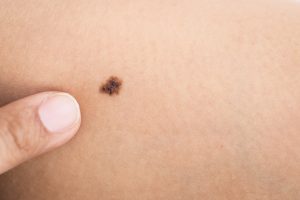
Q: I noticed a small scaly patch on my forehead. It seems like dry skin, but sometimes it’s itchy and forms a little scab when I scratch it. I’ve had it for a while. Should I see a doctor just for that?
A: Yes, if it’s been there for more than a few weeks, you absolutely need to see a doctor for that. It could be a precancer or even a skin cancer, and the sooner it’s treated, the better.
A common precancer called actinic keratosis (AK) generally looks like a dry, scaly patch. It can be pink or yellowish, round or another shape, usually about a quarter of an inch in diameter, but it can grow wider or grow an outward extension like a little horn. An AK may feel rough, different from the skin around it, and it might be a little tender, sensitive or itchy. Generally, AKs develop in sun-exposed areas, including the face, lips, ears, scalp, hands, arms and neck.
It’s best to see a dermatologist, because we can usually diagnose an AK just by looking at it. I generally see AKs in people 40 and older. But I also see them in 20- and 30-year-olds, especially those who have fair skin, light eyes and spend a lot of time outside. If it is thick, large or has a horn, it might need a biopsy to make sure that it’s not a skin cancer. If left untreated, an AK can develop into squamous cell carcinoma (SCC), the second most common type of skin cancer.
I generally treat AKs by freezing them with liquid nitrogen. It’s not a big deal. It takes just a few seconds and you only feel a quick burning sensation. It will scab up and peel off over the next week or two. Once it peels, the skin should be smooth. If you still feel roughness there, you should follow up because it may need further treatment or a biopsy.
Since actinic keratoses develop from years of chronic sun exposure, if you have one, it’s likely you’ll develop more. So if you’ve been diagnosed with an AK, you’ll need a whole-body skin exam. (In fact, all adults should have regular skin exams.) I also recommend that those who have been diagnosed with AK follow up regularly with a dermatologist. People who have a lot of AKs can also have the precursors to these precancers, meaning damage that isn’t yet visible. For those patients we may suggest what we call field therapy to treat a larger area with topical medications, a chemical peel or a special kind of light therapy. It’s much better to be preventive and stay on top of it.
It’s crucial to protect yourself from the sun to prevent future AKs. Plan outdoor activities before 10 am or after 4 pm to avoid peak sunlight hours, and wear broad-spectrum sunscreen, a wide-brimmed hat and sunglasses whenever you’re outside.
Credit: skincancer.org
